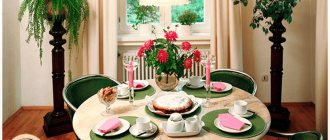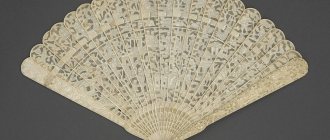The meaning of color according to Feng Shui is of great importance in everything . It is simply necessary to know the basic principles of using flowers in life. According to the Chinese theory of Feng Shui, colors are used, as a rule, according to two principles.
The first principle is the theory of the Five Elements, the second principle is the theory of Yin and Yang . Regardless of the method by which colors are used in Feng Shui, their effectiveness does not weaken. Let's take a closer look at these principles.
The meaning of red in feng shui
In China, this color is considered to be the color of strength, activity, and violent expression of feelings. The combination of red and gold in interior design is an effective means of attracting monetary luck, a symbol of happiness and prosperity. If there is a need to direct qi to areas of wealth or fame, it is recommended to use red tones when decorating them. However, you should not overload the color scheme when decorating your home with shades of red, since this color, among other things, can provoke outbreaks of aggression in people - this is especially true for people of the Fire and Metal types. It is also not recommended to place things of blue and black colors - symbols of Water - next to objects of this color.
The best option for using red and its shades is in rooms reserved for vigorous activity, both physical and spiritual. This will create an atmosphere of inspiration, energy that is under the auspices of Fire. Such premises can easily include sports and game rooms, kitchens, and restaurants. Using accessories in fiery tones in the interior will help strengthen any sector of the home and bring dynamism to work activities. They will give determination and optimism to those in the room.
However, it should be remembered that it is extremely undesirable when an excess of this color is observed in the areas of marriage and family. This color should be present there, but in very limited quantities and in combination with a color that can contain the energy of red, for example white. Otherwise, wanting to awaken passion and love in your partner, you can get the exact opposite result: a scandal, an outburst of unreasonable anger, which can destroy the relationship with your loved one. Also, red color is extremely undesirable for painting gates, doors, windows facing west or east.
Grey
The discreet, restrained color of a cloudy sky is preferred by distrustful and detached logicians. Lovers of gray tend to think long and hard and do not make hasty decisions. Preference for a dim tone is also given by those who unconsciously or quite consciously do not want to attract unnecessary attention to themselves.
In the interior, the shade is neutral and can serve as a basic background. Needs bright accents and additions. A completely gray room evokes melancholy and sadness. You won’t be able to relax in such an environment, but it’s easy to get depressed.
Symbolism of orange
This color is intermediate between red and yellow, combining the strength and energy of the first and the warm good nature of the second. Orange is a very favorable color, emitting a lot of positive, creative energy, conducive to friendly communication. It is most suitable for decorating a children's room, because it is the color of knowledge, which helps stimulate mental activity, imagination and has a beneficial effect on memory. In this regard, it is also most suitable for decorating reception offices, living rooms and study rooms, including school classrooms.
Color by gua number
The gua number is determined by the year of birth: the last two digits are added until the result is a single digit number.
Further calculations are made based on gender and age:
- men subtract the resulting value from 10;
- women add 5 to it;
- young men born after 2000 subtract the resulting value from 9;
- girls born in 2000 (and later) must add 6 to it.
If the final number is 5, the number of gua for women will be 8, and for men - 2.
We look at the results in the table.
| Gua number | Favorable colors |
| 1 | All shades of blue, black |
| 2; 8 | Beige, yellow, pink, red |
| 3; 4 | Brown, green |
| 6; 7 | White, metallic, silver |
| 9 | Pink, purple |
Golden color - meaning in feng shui
This color symbolizes the element of Metal and means honor and respect. In ancient China, only the emperor, his family members and a few selected courtiers were allowed to wear gold-embroidered clothes. The warm shimmer of gold is intended to set people up for a positive and optimistic worldview, strengthen their sense of self-esteem, and awaken the positive qualities of character characteristic of people of the elements of Metal, Earth and Water. Being the color of money, gold in combination with red symbolizes material well-being. For this reason, it is customary to have objects painted in a combination of these colors in the house precisely for the purpose of attracting monetary luck and achieving success in the financial sphere. But luck will accompany only those who work painstakingly, diligently and persistently. Red and gold symbolism is most effective when placed in areas of wealth, marriage, and children.
What to consider in finishing?
When choosing colors according to Feng Shui, special attention should be paid to the finishing: furniture or decor can be rearranged, but repainting the walls or redoing the floor will be much more difficult.
Walls
It is logical to choose wallpaper or paint, guided not only by the rules of Chinese philosophy, but also by common sense. For example, anyone would feel uncomfortable in a completely red room.
When decorating walls, give preference to light, pastel, neutral shades. Exception: accent surfaces (behind a sofa or bed, for example). We exchange indigo for heavenly, canary for creme brulee.
Another important point is the area of the room. The walls should not put pressure, so in small rooms they prefer light tones: beige instead of chocolate, Gainsborough instead of wet asphalt.
Floor
In addition to the cardinal directions, the surface itself has a great influence: for example, the floor is a symbol of the earth, since it is essentially the foundation of the room.
Accordingly, any earth tones are suitable for its design: coffee, chocolate, walnut, sand. A win-win option is classic wood-look coverings.
Ceiling
According to the logic, the floor is the earth, the ceiling is the sky, that is, the air. The ideal solution is a flat white ceiling. If you want color, pale blue will do.
The ceiling should not have complex structures, beams, mirrors, dark shades - all this interferes with the smooth flow of Qi.
Doors
Using white color in feng shui
White color in Feng Shui, as in many other philosophical movements and teachings, is a symbol of purity of thoughts, correctness of actions, and chastity. It is designed to awaken the desire for exact sciences, painstaking, delicate crafts - such as watchmaking, pharmaceuticals, calligraphy.
Bright white color in Feng Shui is equivalent in meaning to light, because it attracts qi just as effectively. But you should be very careful about the dosage of its presence in the house so as not to upset the balance of yin and yang. A room decorated exclusively in white will blind with cold, creating in the souls of those present in it the same restlessness as when being in a completely black room. In general, the use of pure white color is not welcomed in Feng Shui, since it is considered, like black, to be a disharmonious extreme that is not found in nature in its pure form. Even the human eye is capable of perceiving up to several dozen shades of white, but not pure color.
White, considered “dead” in Feng Shui, is usually combined with any other “living” color. Being very strong and dazzling, it can drown out another color, so xianshengs advise reducing the percentage of its presence in the interior to a minimum. An equal combination of the color in question with its main competitor - black - is considered in Feng Shui a symbol of harmony and unity of all living things (monad). The combination of white and gold in the interior of a room helps to activate the children's zone, and with red - the marriage zone.
Feng Shui pays great attention to creating the color scheme of a room. When choosing a color for your rooms, consider the following emotional, but proven by thousands of years of historical experience, characteristics below.
White color in feng shui.
White is a synthesis of all colors, the ideal color, the color of dreams.
In Feng Shui, this color belongs to the Metal element, the cardinal direction is West. Therefore, feng shui beginners are not recommended to paint walls facing west only white. The point is that if you don't have enough knowledge in applying Feng Shui techniques, you run the risk of stimulating the energy of Western rooms too much. The ideal feng shui combination would be a combination of white with yellow tones, and the brighter the latter, the better.
Its impact on our lives is reflected in divine self-realization, humility and creative imagination. This is the color of purification. White color leads us to a higher spiritual mood and divine love. Symbolizing purity, it can be a great healing color as it contains energy and the power of transformation.
White can be successfully used in any room of the house. However, if you have a completely white room with a completely white interior, then it will not be cozy or attractive. Always add colored decorations and paintings, or complement white with apricot, gold or blue shades.
Black color in feng shui.
Black is the opposite of white. It symbolizes a difficult perception of life. Black color absorbs other colors. It also symbolizes efficiency, seriousness, and closeness. Black color focuses attention on the experiences of the inner world.
In Feng Shui, black belongs to the element Water and represents impending power. Black color is focused on the inner world, while white is focused on the outer world. Black is the end and the beginning. In the darkness new life is born. The day ends and begins with darkness. Using black as the main color in a room can be depressing or even overwhelming. A black room interior, however, can add drama and dynamism to a room and can highlight and give it special meaning.
Gray color in feng shui.
The gray color in the interior of a room evokes sad thoughts. You will not get relaxation in a room with gray walls.
Gray is a passive color, joyless and boring. It does not have strong radiation, i.e. it has a weak effect on people. It restricts and slows down both emotional and mental activity. In private houses or apartments, gray is used only to highlight and draw attention to bright color accents.
Golden color in feng shui.
Golden can hardly be called a color. However, in color therapy, this color is successfully used to treat physical and mental ailments. Golden smoothes out stress. It helps with spiritualistic sessions and meditation, strengthens self-confidence and charges with positive energy. In practice, gold color should never be used in large quantities.
In Feng Shui, this color belongs to the Metal element. It strengthens a person's physical and mental strength and also increases his wealth.
Green color in feng shui.
Green is the color of nature, of life itself. Green color has a calming and harmonizing effect on the entire body and promotes internal harmony. It leads to internal stability and calms the nervous system. If you suffer from frequent mood swings or want to concentrate better at work, introduce more green color into your interior.
Green color in Feng Shui belongs to the Wood element, the cardinal direction is East. Walls facing east should not be painted entirely green. Otherwise, you risk overstimulating the energies of the eastern room. According to Feng Shui, green is a symbol of peace, harmonious relationships and numerous offspring (including in a figurative sense).
Green is absolutely suitable for the bathroom. The green color you use in the bathroom should be either bright green, like spring, or even and clean, like tree foliage, but not khaki or dirty green.
Blue color in feng shui.
Blue is the color of the sky, symbolizing spiritual sublimity and purity. Blue color belongs to the element Water. It harmonizes the flow of energy in the body, calms tense nerves and erases aggressive thoughts, and helps to focus on internal experiences.
Blue color is ideal for use in rooms where residents are passive. However, you should not make plain blue walls. It is better to use shades of blue as color spots on wallpaper of a different color.
According to Feng Shui, blue color belongs to the sky and Water, the cardinal direction is north. Therefore, walls facing north should not contain blue.
A bedroom in blue tones will be very good at calming a hyperactive child. Blue is also a great color for a meditation room or bedroom, or any other room where you would like to feel a sense of peace.
Yellow color in feng shui.
Yellow color symbolizes calmness, ease in relationships, and intelligence. In general, yellow is the color of the sun, good mood and positive, cheerful people. This color symbolizes joy, spiritual harmony and cheerful thoughts.
Yellow color stimulates creativity and even helps with physical ailments. It is especially useful for those recovering. Yellow color stimulates the functioning of the endocrine glands. Yellow is a Yang color. Yellow objects will activate the energy of creative people.
According to Feng Shui, the color yellow belongs to the element Earth, the best place to place yellow objects is in the center.
Yellow color is great for a home office. It is desirable wherever you want to experience thought-boosting and stimulate conversation. Yellow kitchens are more likely to be social gathering spots for family and friends and usually evoke a sense of affluence. Yellow will also be good in a room where the whole family usually gathers to discuss pressing issues. It encourages people to open up and at the same time promotes spiritual uplift and optimism. A smooth, bright yellow color is suitable for a nursery, as it gives positive emotions and at the same time normalizes mental activity.
Red color in feng shui.
Red is the color of passion. Red activates blood circulation, hematopoiesis and heart function, increases blood pressure, warms and enhances energy flows. But use this color sparingly in the interior, because... red evokes aggression.
An abundance of red in the bedroom leads to nervousness and insomnia. The Red Table will whet your appetite, but if you're on a diet, it may not be the best option. The color red in a study or study room or even a living room encourages movement and activity.
Feng Shui considers red to be a very powerful color. It belongs to the element Fire, its cardinal direction is south. The color red in Feng Shui also symbolizes joy and happiness. In China, red has always been considered the color of good luck. That's why there are so many red and gold colors in the interior of Chinese restaurants.
Orange color in feng shui.
Orange is the color of happiness and communication. This is brightness and kindness, tolerance and sociability. Orange is suitable for any room where you will organize meetings of friends or fun holidays; This color is especially good for a party atmosphere.
Orange is a very strong color because it is a mixture of red and yellow. It activates vital energy, stimulates the start of new things, drives away sadness, melancholy and depression. Orange is not suitable for the dining room and kitchen; it stimulates appetite and leads to excess weight. In addition, orange visually reduces the size of the room.
Pink color in feng shui.
Pink is the color of spring and all living things.
Pink is the color of little girls. According to Feng Shui, it emphasizes their future femininity and programs dedication in love and the ability to evoke positive feelings in others.
Pink color drives away aggressive moods. If you paint the walls of a small room pink, it will appear larger. Pink color is also good for work spaces where there are a lot of different people.
Purple color in feng shui.
Purple is a serious, festive and mysterious color. This color strengthens harmony and eliminates disharmony in all areas of human life. The color violet can enhance the ability to concentrate, it calms the nerves and relieves insomnia. Like blue, violet color calms, pacifies, and comforts. Very often, purple is associated with inner insight and intuition.
Purple is a very powerful color; too much of it in your home is not recommended. A splash of purple is good for decorating a white, green or even yellow room. Purple can be mixed with white to achieve a soft shade of lavender and lilac - great for a room where you practice spirituality.
Brown color in feng shui.
Brown and all its shades are preferred by those who stand confidently on their feet. People who have a soft spot for him value traditions and family.
However, in a house with brown walls there is not enough air; it has a depressing effect on the psyche. It is ideal to choose light brown colors for furniture. Dark brown evokes negative thoughts and blocks positive ones.
Brown color belongs to the element Earth. It evokes a feeling of security and inner peace, relieves fears, stress and anxiety, under one condition - choose light shades!
When choosing a particular color for your room, remember that color is very individual and carries personal characteristics. A lighter or darker shade of a particular color can significantly change your perception of that color.
Harmony and prosperity with Feng Shui! Natalya Titova, Feng Shui and Chinese astrology consultant.
Meaning and use of black
Traditionally perceived as the color of night and darkness, a sign of something mysterious and terrible, in Feng Shui black is considered a positive color, symbolizing protection and reliability. Oddly enough, along with gold, it also symbolizes money. Therefore, Feng Shui recommends that when decorating an office or study, be sure to ensure that in an aquarium with goldfish there is always one black fish as a symbol of protecting wealth. Most often, black, being the color of Water, is used in combination with white, silver, gold, green - the colors of the elements adjacent to Water in the generation cycle.
Elements of the interior and its accessories, designed in the mentioned colors, will help create an energetic and at the same time restrained atmosphere in the room, favorable for thinking, learning and making important decisions. It should not be forgotten that black should not be the predominant color of the palette, otherwise it will suppress other colors, having a depressing effect on those present. In order to activate the knowledge zone, it is useful to use a combination of black with blue and green (Water and Wood) when decorating the interior. To attract chi to the career and teacher zone, you can use black and white elements in the interior.
In an office whose interior is designed in black and white, employees have a better chance of earning additional profits, acquiring new partners, winning the favor of management and moving up the career ladder. The black and white design of the living room and lobby will help its owner to gain determination and courage, to express his abilities and talents. However, if you use black color to decorate gates, doors, window frames that are directed to the north or south, this can scare away good luck and success.
Blue
A beautiful and multifaceted shade of ultramarine or sea green charges the room with a special “watery” energy. The blue room has a calming effect on the psyche and puts you in a peaceful mood. Cholerics are recommended to relax in blue bedrooms. Due to the specific tone, the interior in bluish tones cools, therefore it is recommended for “hot” southern rooms.
It is attractive and trustworthy, which is why it is often used in the decoration of offices of companies and political parties.
Like purple, it is considered the color of loneliness. Suitable for business wear and work interiors.
Blue color - meaning in feng shui
Blue is one of the most calm and peaceful colors. When contemplating objects painted in this color, the psyche calms down, emotional unrest is pacified, thoughts are tuned into a philosophical mood. That is why feng shui experts recommend decorating meditation rooms in blue tones, which promotes better immersion in thoughts about Heaven, fate, Tao, and universal harmony. Related to blue - blue and indigo - help to sharpen intuition and stimulate spiritual desires. These colors attract additional chi to the areas of family and knowledge. It is logical that Xianshengs recommend painting those rooms in the house that are protected by Water, such as the bathroom and toilet, in the colors of Water.
Brown
Strict and formal color. Remember what the offices of respectable, highly paid lawyers look like: high-quality furniture made from solid expensive wood, heavy dark panels on the walls, impressive spines of book volumes. This is all the effect of brown - a serious and respectful color.
What place does brown have in the interior? Perhaps this is the main background in classic British-style interiors. Good for offices and libraries. Allows you to concentrate and detach from external stimuli
Color plays an important role in the interior. Feng Shui masters know a lot about the psychology of color and skillfully use this knowledge in practice. The right shade will bring prosperity into your life, but the wrong tone can lead to devastating consequences.
Purple color - symbolism
Purple is the color of mystics, idealists and clergy. It has a stimulating effect on the imagination, at the same time calms and energizes, evoking a feeling of something unearthly, wonderful, magical. The impression made when contemplating this color is different for everyone: for some, their thoughts turn to God, for others, the creative process is activated and a desire for noble deeds appears, while others are immersed in dreams. Thus, this color causes a heightened sensory perception of the world, and for this reason it is not recommended for use in rooms intended for relaxation.
Feng Shui experts believe that the best option for using this color in interior design is to activate the wealth zone. Having decorated this area in purple tones, the owner of the house will feel an influx of creative inspiration, an influx of creative energy, and new ideas will visit him. At the same time, he will have the opportunity to concentrate and get down to business. Experienced xianshengs claim that in order to attract inspiration, energy, optimism and progress into the house at the same time, it is recommended to use the following recipe: decorate the wealth zone in a combination of purple, red and green. By properly managing this potential, you can overcome any difficulties and achieve success.
The effect of red on the psyche
AliceKeyStudio/Pixabay
This energetically powerful color has the following effects on our mental and physical state:
- tones and stimulates;
- makes you blink more often;
- sharpens the sense of smell;
- warms;
- inspires optimism and confidence in the future;
- helps to cope with life's troubles;
- increases mood and optimism;
- helps with nervous and physical exhaustion;
- helps overcome the blues.
Complex and contradictory color simultaneously arouses interest and signals danger and prohibition. So, red dishes suppress appetite. Although previously it was common to think the opposite. So if you want to lose weight, get a plate and cup in this color.
Green color in feng shui
Green is a symbol of spring, growth, peace and quiet. This color of the Wood element is intended to calm, pacify, relieve stress, reduce sorrow and relieve mental pain. The wealth zone, decorated in green-yellow and green-red tones, will attract monetary luck and increase the growth of the family’s well-being. The green zone of glory will also attract the flow of qi and bring harmony to the relationship with society. The yellow-green color scheme also promotes calm and an optimistic mood, which is not the least important condition on the path to good luck and a worthy place in society, as well as career advancement. Green color is most favorable for decorating a rest room in an office, living room or dining room; light green is well suited for decorating a nursery.
How to combine colors correctly?
As in any practice that works with flowers, Feng Shui has its own successful and unsuccessful combinations.
See recommendations for the right color combination.
Successful
The right colors enhance each other and promote the unhindered flow of vital energy Qi. To avoid mistakes, remember the rule:
Fire feeds earth, earth feeds metal, metal feeds water, water feeds wood, wood feeds fire.
If you think about it, everything is logical, fire burns on a tree, the tree grows thanks to water. Accordingly, in the fiery glory zone you can use woody shades, perfectly combining orange with green, red with brown.
Unsuccessful
The destructive cycle looks like this:
Wood spoils earth, earth spoils water, water extinguishes fire, fire melts metal, metal destroys wood.
That is, in the same zone of glory (fire, red) you cannot use water (blue, black, cyan). And in the water element (north) earthy, terracotta tones are prohibited.
The meaning of yellow in feng shui
Naturally, this color cannot symbolize anything other than the sun, good luck and joy. Yellow color is a source of positive energy. The sun gives life to everything on Earth: plants, animals, humans. This color is a stimulus, a source of fun, enlivening the interior of a home and instilling hope for the best. Yellow color with its stimulating properties is best used in the fame sector and the center of luck to receive rewards for optimism, activity and a humane attitude towards people. It is used to bring happiness, warmth, good mood into the home and activate positive thinking.
For this reason, Feng Shui experts often recommend using this color when decorating the living room, since this room is a kind of spiritual center of the house, and it is in this place that communication between family members most often takes place. Thus, color is a fairly effective means of activating bagua zones and attracting qi into the home. Competent and timely decoration of your home in the right color scheme will help you achieve success both in your personal life and in work and study.
When decorating an apartment or house, you should avoid monotony of room interiors. Each room should be individual, carry a certain mood and reflect the tastes, habits, and character of its occupant. The room should be comfortable, first of all, for its owner. Therefore, some experts advise starting to decorate a house in the colors that its inhabitants prefer, and bright spots of stimulating colors can be added as the need arises.
© Ogudin Valentin
Cautions
Meanwhile, you cannot use red in abundance. Being an extremely active and energetically saturated color, it will begin to have a detrimental effect on the lives of the owners of such a house. And in particular, it can cause increased violence and aggression in the family. Therefore, the idea of transforming the house into a true abode of red cannot be called reasonable. If this color is used excessively, an outbreak of violence or aggression may occur in the family. Therefore, it is not recommended to be shown to people suffering from mental disorders.











